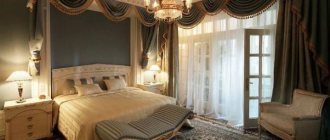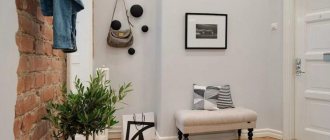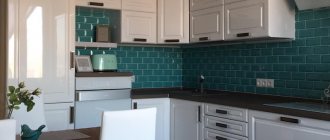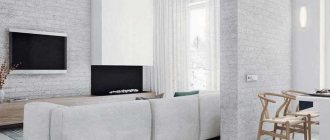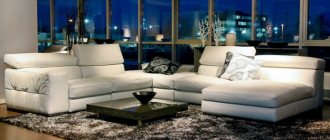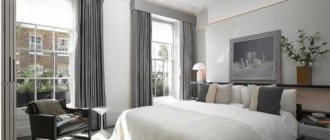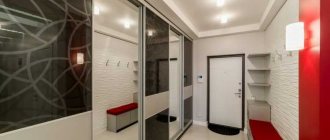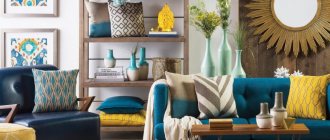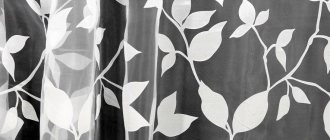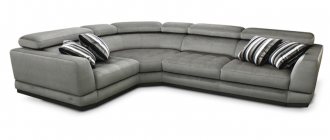Home Articles Furniture in the Stalinist style
The Stalin Empire style is a unique interior design style that emerged on the territory of the USSR during the reign of the well-known political leader I.V. Stalin. It was not some kind of new revolutionary discovery, but simply combined elements of classical, baroque, and also some art deco details. Furniture in the Stalinist style also combined their characteristic traditions, expressed in grandeur, luxury and monumentality. For many years it has been relevant and fashionable, since in general an interior decorated with such items turns out to be very cozy, harmonious and at the same time majestic.
A classic Stalinist-style apartment usually had up to five spacious rooms with high ceilings and large windows. The design of the apartments featured stucco, ceiling cornices and herringbone floors. In such a room one could often find red carpets, heavy curtains with tiebacks, crystal chandeliers with rosettes and tall grandfather clocks.
History of style
This style originated in the USSR in the mid-30s of the 20th century. Initially, the Empire style was a pompous, majestic architectural style that arose in France during the time of Napoleon the First. In the 30s of the twentieth century, such luxurious, monumental buildings began to be built in the Soviet Union, when J.V. Stalin began to rule the country. In the 50s, such architecture began to be sharply criticized, considering it an excess that was unacceptable for a Soviet person, and after Stalin’s death, all the projects started were sharply simplified, eliminating decor as much as possible, and in some places sharply reducing the total area and ceiling heights. Multi-room apartments were mostly given over to “communal apartments”, in which several families lived at the same time, using a common kitchen and bathroom.
Characteristic features of the style
A standard “Stalinka” apartment consists of three to five, less often two or six to seven separate rooms, a kitchen with an area of seven to fifteen square meters, a huge living room, and a spacious hallway. One-room apartments were built extremely rarely, and in three-ruble apartments two rooms were sometimes adjacent. All rooms have ceilings more than three meters high, vertically elongated windows facing one or two sides, and in some places there are bay windows. Typically, such housing is located in the “historical” center of a large city - the view from the windows is appropriate.
Apartment design from the time of Stalin combined individual features of Baroque and Napoleonic Empire, neo-Gothic and Art Deco, classicism and modernity. The thick walls of houses of this era were made of red or white brick and other non-combustible materials, and the buildings themselves had at least two floors, an abundance of stucco, and real columns. The doors here are also quite high, often double-leaf, the walls are decorated with profile cornices, and the wide “front” stairs are decorated with carpet runners.
In another way, “Stalin” buildings were called “full-size apartments” or “full-size in houses of the 50s.” Not only residential buildings, but also theaters, departmental buildings, metro stations, sports facilities, and universities were decorated luxuriously and on a grand scale. City buildings were grouped into entire ensembles; the architects of that time tried to use all the achievements of construction and fine art. The principle “the more the better”, gigantomania and optimism were in effect everywhere.
Bedroom and children's room
To furnish the bedrooms, a standard set of furniture was used:
- Large double bed;
- Bedside tables on both sides of the bed;
- Small lamps for reading before bed;
- Trellis with dressing table function;
- Wardrobe;
- Large chest of drawers made of natural wood.
A feature of Stalin's apartments was the abundance of built-in mezzanines and closets scattered throughout the apartment. Passage rooms were often included in the layout, and sometimes separate entrances to the bathroom were provided. Children's decoration was not given much importance. The furnishings consisted of domestically produced lockers and beds.
Antique clocks with a striking mechanism, plaster figurines, candlesticks, paintings, vases and silverware were used as accessories.
Features of the color palette
The colors of the interiors of the first half of the 20th century are very modest, practically devoid of bright colors. The furniture chosen is predominantly dark, the walls are pastel shades, the carpets are red-brown, the doors between rooms are white, with multi-colored glazing.
The most suitable color combinations:
- linen with mahogany;
- agate gray with terracotta;
- marsh with woody orange;
- antique azure with beige-red;
- lavender with dark brass;
- pale gold with chocolate brown;
- bluish-green with beaver;
- protective blue with light chestnut;
- mustard with iron gray;
- emerald with brick;
- brown-orange with khaki;
- coral with cream;
- creamy yellow with violet-black;
- dandelion with opal green;
- ocher with silver-pink.
Even a monochrome interior allows for bright color accents - curtains, pillows, carpets, paintings on the walls.
Interior design color scheme
- White is the predominant color in the Empire style. Its role is to create an elegant festive atmosphere. The ceilings and floors are decorated in white, with the addition of various patterns. There are also white curtains on the windows, usually for formal rooms.
- Dark red, cherry, wine red are also used in the Empire style. Often these colors are present in pieces of furniture, carpeting, and curtains. The color symbolizes elegance, high status and greatness of the owner of the house.
- The color of gold is present in the interior in large quantities and is combined with almost all additional shades. Most often it is used in combination with white, when decorating patterns on walls, mirror frames, and there may also be a large number of gold-plated accessories. This emphasizes the wealth as well as the power of the owner.
- Cool blue color is almost always combined with gilding; this tandem was used for boudoirs, as well as rooms for receiving guests.
- Ivory is used for bedrooms, furniture and decor.
What materials to use when decorating rooms
Finishing materials are used exclusively natural:
- stone – mainly granite, marble;
- wood - oak, pine, spruce, cherry, hornbeam, walnut, Karelian birch, etc.;
- metals - bronze, brass, steel, silver, etc.;
- crystal;
- ceramics;
- gypsum.
The floors are usually laid out with parquet, arranged in a herringbone pattern, but not common for the entire apartment, but for each room separately. The walls are decorated with stucco panels, half-columns, plaster brackets, caissons, corner details, textured niches, etc. The ceiling must have a stucco rosette for a chandelier, the same intricate ceiling cornices, and other similar decorations. The doors are made of wood, plywood, have panels, handles painted with gold paint, and platbands with 3D carvings. They match the color of the floor covering or are painted with white oil paint.
The floors in the bathroom and kitchen are laid out with ceramic tiles, less often - with natural stone, mainly red-brown colors, and the walls - with light tiles, richly decorated with plant patterns; a narrow contrasting border is allowed.
Finish options
It is necessary to strictly follow certain rules when finishing. Whether it is a country mansion or the interior of an apartment, a city house, a cottage - the main design recommendations will be the same. Preference should be given to natural materials. The quality requirements are really high. An interior door made of solid pine would be out of place here, but an oak door decorated with carvings is quite consistent with imperial trends. In addition to valuable types of wood, the Empire style welcomes the use of marble, travertine, and other types of natural stone. Gilding, bronze, silver, and crystal are widely used in the decoration of protruding elements.
Stan
The classic version of wall upholstery for the Empire style is the use of luxurious fabrics - brocade, silk. Current trends offer more affordable solutions. Textile or textured wallpaper that imitates the interweaving of threads will harmoniously fit into the design.
You can achieve a reliable transfer of the Empire style in the interior using the following techniques.
Thoroughly plaster the walls, then cover them with matte paint. Suitable shades are white, beige, sand, olive, soft peach. Select individual zones on the wall surface with protruding elements
It is important to observe the principles of symmetry. Overhead half-columns and stucco molding are suitable for zoning. Decorate each area using wall paintings or stencils. Place mirrors that visually expand the space. Paint all protruding elements gold
Stucco molding, borders, frames should be sophisticated and elegant.
Wall surfaces in the Empire style can be decorated with paintings in carved, richly decorated frames. It is also acceptable to use photographs - ceremonial portraits in the spirit of the era, stylized as antique. You can print them on tapestries to get rid of the excessive modernity of the design solution.
Paula
It is not customary to completely hide floor coverings in an Empire style interior under carpets. They themselves are of great value and are a complete work of art. Most often, the floor is decorated with expensive parquet with a complex mosaic pattern. Natural stone tiles and marble are also considered appropriate. When creating Empire style floors, monochromatic decor should be avoided. In such interiors, artistic parquet is used, which allows the formation of complex patterns on the surface.
Ceiling
The decoration of the ceiling in the Empire style implies conciseness and rigor in the choice of colors. The most commonly used traditional coloring is white and ivory. Empire style requires a large area of ceilings and wall heights. The following techniques are traditionally used in finishing:
- painting with matte compounds;
- applying applied stucco molding;
- zoning with allocation of the central area;
- the use of large chandeliers and other lighting fixtures;
- multi-tiered.
The Empire style ceiling is one of the foundations of the style and determines the pomp and solemnity of the atmosphere. It is customary to decorate it richly and pompously, adding rosettes and other architectural details.
Furniture selection
The furniture chosen is luxurious, high-quality, massive, mainly made of natural wood (oak, walnut, rosewood) and metal. It is often varnished and decorated with 3D carvings and mosaics. These are cabinets with carved “crowns”, convex sideboards, round or oval dining tables, leather chairs and sofas with high backs, heavy wooden chairs with turned legs, beds with balls or peaks in the corners. Wood carving is welcome here both in the form of complex plot bas-reliefs and simple “geometric” designs. Overlay slotted elements made of valuable wood are acceptable. In addition to natural or artificial leather, various fabrics are used as upholstery material - plain or with floral patterns.
Furniture in the Stalinist Empire style: tables, chairs, bookcases
Furniture, as a rule, was made of dark wood - walnut or oak. Furniture made from mahogany looked luxurious. The table in the Stalinist Empire style was often lacquered, usually decorated with crystal vases, which simultaneously served both decorative and practical functions.
The rooms were equipped with tall bookcases, usually with glass doors. A grandfather clock made of dark wood is another detail typical of the Stalinist Empire style. There could be a coffee table in every room, but not from metal or glass, as in our time, but from wood, and its legs were often lavishly decorated with carvings. The walls were predominantly decorated in light pastel colors.
A round table was installed in the dining room, and massive chairs around it.
To give the interior a cozy atmosphere, white tablecloths, massive curtains, figurines, candlesticks, and crystal vases were used. Sideboards were decorated with high-quality dishes, often made of light porcelain. You can give your room an empire style using silverware.
Lighting
The main lighting fixture of this era is a luxurious crystal chandelier located in the middle of the ceiling. Later, similar structures were made of plastic, which significantly affected the appearance and durability of the device. Individual areas were illuminated by floor lamps, often with textile shades decorated with floral patterns and fringe. Wall sconces, usually styled as torches, were mounted on bronze figured brackets above the kitchen table and bed. The workplace was illuminated by a table lamp with a greenish shade on a flexible base. In the children's room, in addition to the main light, there were small night lights, plugged into an outlet, decorated with stone or plastic. In modern times, the design is complemented by LED lighting, which, with the right approach, will not at all disrupt the basic style.
Selecting textiles for window decoration
Window draperies are chosen to be dense, heavy, creating a solemn atmosphere. They have several layers, a large number of folds, fringe, and tassels. In the bedroom, blackout curtains are preferred, protecting the sleeper from the morning sunlight; in the kitchen - shorter, lighter ones. Doorways are decorated with the same curtains as the windows and tied with golden cords. Fabrics are preferable to natural, plain, calm colors or sharply contrasting with the color of the walls. It is advisable that the curtains match the color of bedspreads, carpets, and other indoor textiles.
If there are several windows on one wall, they are decorated with one common curtain, covering almost the entire wall completely.
Room design examples
The total area of a Stalinist two-room apartment is about 30 meters, a four-room apartment is about 60 meters, a seven-room apartment is up to 160 square meters. The more rooms there were, the more spacious each of them became.
What kind of premises were there:
- kitchen;
- one or more bedrooms;
- cabinet;
- living room;
- bath or shower;
- restroom;
- hall;
- pantry.
There were no dressing rooms in those days - clothes were stored in built-in closets and storage rooms. For children's bedrooms, special furniture, with the exception of a crib, did not exist at all - for these purposes, the smallest rooms were chosen, where they placed a crib, a simple cabinet, a table with a chair, a box with toys, and a bookshelf.
Apartments of the Stalinist era are replete with high built-in wardrobes, which house most of the things, so there is a lot of space in the rooms for books and decorative elements.
Living room
The area of the Stalinist living room is from 16 to 30 square meters. The ceilings and partly the walls are richly decorated with stucco, in the middle there is a multi-tiered crystal chandelier. Along one of the walls there is a wall cabinet, in which there are always many thick books with neat “spines”, and in the glazed sections there are beautiful ceramic dishes, a tea set for six to twelve people, and many porcelain figurines.
The main decoration of the living room is the TV; it is placed on a stand with four cone legs or a wall console decorated with stucco. In the center of one of the walls there is a floor or hanging clock with a chime, richly decorated with carvings; on several others there are paintings in the spirit of rough “Soviet realism”, decorated with heavy frames. Without fail, there is a sofa covered with luxurious drapery, complemented by a pair of armchairs and a carved dressing table. All furniture elements are united by a patterned carpet that occupies most of the room. Photo wallpapers depicting a mid-twentieth century cityscape are also acceptable.
If possible, the principles of symmetry should be observed with respect to the compositional center of the room - fireplace, TV, sofa, painting, etc.
Kitchen
The kitchen of the Stalinist Empire style has an area of 7 to 15 meters. There is usually no kitchen set as such, there is only a not very spacious sideboard with dishes, table linen, and a low round refrigerator. The worktop is made of natural stone or oak; underneath there are drawers, sections for silverware, and various kitchen utensils. A few household appliances are placed on any horizontal surfaces. The dining area is decorated with a dining table covered with a fringed tablecloth; chairs are also draped with removable covers. Crystal fruit bowls, potted foliage plants, and heavy metal candelabra are placed in prominent places.
Bedroom
The average area of any bedroom is about nine meters. A single or double bed is located in the center of one of the walls, the headboard is decorated with stucco moldings, next to it there are one or two bedside tables or a carved dressing table with a valance in the color of the curtains. The shelves above the bed are decorated with black and white photographs in wooden frames and small figurines made of copper or bronze. There is also a small glossy two-door wardrobe, which at that time was locked with a key, or less often - a forged chest for storing linen and various “belongings”. Beige-brown wallpaper with stripes or floral patterns will complement the chosen style. Be sure to lay a carpet on the floor; if desired, it can be supplemented with a wall carpet.
If the room seems cramped, place a large mirror opposite the window, which, by reflecting light from the window, significantly expands the space.
Office-library
It was believed that everyone in the USSR read, so every family had a lot of books. A study with a desk was usually combined with a library, which consisted of solid wood shelves up to the ceiling. Sometimes they hid the surfaces of all the walls, and in order to get the desired book from the top shelf, you had to use a stepladder or a special wooden stand with two or three steps, because the ceiling height was often about four meters.
In the modern version, there may be a little less books, and the desk is replaced by a computer. On open shelves there are plaster or bronze figurines, stylized for that era. A map of the Soviet Union, a red flag or an image of the coat of arms is hung on the wall.
Hallway
This room is decorated no less luxuriously than all the others. There is herringbone parquet or real marble on the floor, dark patterned wallpaper combined with wooden panels on the walls, stucco molding and a ball lamp on the ceiling. From furniture, a carved trellis, a wooden wall or metal floor hanger, a small couch combined with a shelf for installing a home telephone are appropriate here. The carpet will also fit in with the theme.
Main features and features
Translated from French, Empire means “empire,” so everything that belongs to this style (decor, furnishings, and even the smallest detail) should demonstrate the grandeur and luxury of the royal dynasties.
True imperial style requires breadth and scope - huge rooms, floor-to-ceiling windows, high ceilings and swinging doors. Pretentious furnishings and monumental decor will be inappropriate in a standard apartment.
The characteristic features of the Empire style include:
- symmetry - paired parts and repeating patterns are used to decorate the interior;
- scale - all finishing items and furniture are massive and large;
- luxury - expensive finishing materials, fabrics and precious metals;
- solemnity - all the rooms in the Empire style seem to be awaiting the arrival of distinguished guests;
- clear layout - all objects take their place, and rearranging at least one of them disrupts the entire composition;
- centric arrangement of furniture from the center, which is used as painting or stucco in the center of the ceiling, or a pattern on the floor;
- military themes - shields, flags, coats of arms, blades and armor;
- geometric patterns (ovals, diamonds), as well as bees and swans. The bee is the symbol of Napoleon, and the swan is the symbol of Empress Josephine;
- an abundance of decor from Ancient Rome - columns, bas-reliefs, pilasters, porticos, monuments, paintings and stucco with symbols of victory;
- huge mirrors;
- Large size paintings.
Premises in this style have a solemn and official appearance, therefore in modern realities the Empire style is used to decorate the interiors of official institutions and offices of high-ranking officials.
Symbolism of the Empire style: swan and bee
Josephine's bedroom, decorated with a swan figure
Elements of Stalinist decor, accessories
The decorative elements of the Stalinist Empire style are very original - five-pointed stars, a hammer and sickle, images of ears of wheat tied with a ribbon, laurel wreaths. These are voluminous plaster or carved panels depicting ordinary working people, enthusiastically working for the benefit of a great country. On shelves, tables, and other prominent places there are bronze, wooden, porcelain figurines or sculptural groups of ideological orientation. There are also bas-reliefs with lions, as well as inlays with paintings of socially significant events.
